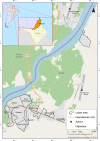Complex malaria epidemiology in an international border area between Brazil and French Guiana: challenges for elimination
- PMID: 31007535
- PMCID: PMC6458633
- DOI: 10.1186/s41182-019-0150-0
Complex malaria epidemiology in an international border area between Brazil and French Guiana: challenges for elimination
Abstract
Background: The epidemiological surveillance of malaria is a necessary intervention for eliminating the disease from the planet. The international border zones of the Amazon continue to be highly vulnerable to malaria since population mobility impedes elimination. Although in the past few years, cases of malaria have had an essential reduction in Brazil, this trend was not confirmed in municipalities along the border. This study aimed to establish the epidemiology of the disease during the last 13 years in Oiapoque, a Brazilian municipality at the international border with French Guiana, an overseas department, to develop strategies for the control/elimination of malaria in these areas.
Results: Data collected from 2003 to 2015 from the Malaria Epidemiological Surveillance System was used. It was found that, despite the important reduction in cases (68.1%), the annual parasite index remained a high epidemiological risk. The disease is seasonal in that the period of highest transmission occurs between September and December. Between 2003 and 2015, eight outbreaks were identified, with one of these lasting 15 months between August 2006 and October 2007. There were changes in the epidemiological profile, with imported cases representing 67.7% of cases from 2003 to 2007 and representing 32.9% of cases from 2008 to 2015 (p < 0.01). The greatest number of cases was among Brazilians coming from the artisanal gold mines of French Guiana. There were also changes in the profile of autochthonous malaria with an increase in urban cases from 14.3% in 2003 to 32.3% in 2015 (p < 0 .01). The burden of malaria in indigenous areas was also very high (67.3% in rural areas) in 2015. There were changes in the parasite species profile with a significant decrease of cases of Plasmodium falciparum (p = 0.01). Children under 15 years old, representing 9.7% of cases at the onset of the study, accounted for 34.2% of case notifications (p < 0.01) in 2015. Also, 74% of cases in 2003 and 55.9% in 2015 (p < 0.01) were among men.
Conclusions: The fragility of local health services in cross-border areas continues to be an obstacle for malaria elimination.
Keywords: Amazon; Elimination; Illegal gold miners; Malaria; Oiapoque.
Conflict of interest statement
The Human Research Ethical Committee of the Institute Oswaldo Cruz (IOC/Fiocruz), gave study approval (Approval number 647/11).“Not applicable”The authors declare that they have no competing interests.Springer Nature remains neutral with regard to jurisdictional claims in published maps and institutional affiliations.
Figures






Similar articles
-
Perceptions about malaria among Brazilian gold miners in an Amazonian border area: perspectives for malaria elimination strategies.Malar J. 2021 Jun 26;20(1):286. doi: 10.1186/s12936-021-03820-0. Malar J. 2021. PMID: 34174880 Free PMC article.
-
Resurgence risk for malaria, and the characterization of a recent outbreak in an Amazonian border area between French Guiana and Brazil.BMC Infect Dis. 2020 May 26;20(1):373. doi: 10.1186/s12879-020-05086-4. BMC Infect Dis. 2020. PMID: 32456698 Free PMC article.
-
Prevalence of Plasmodium spp. in illegal gold miners in French Guiana in 2015: a hidden but critical malaria reservoir.Malar J. 2016 Jun 9;15:315. doi: 10.1186/s12936-016-1367-6. Malar J. 2016. PMID: 27277831 Free PMC article.
-
Sexually transmitted infections on the border between Brazil and French Guiana.Front Public Health. 2023 Jan 25;11:1059137. doi: 10.3389/fpubh.2023.1059137. eCollection 2023. Front Public Health. 2023. PMID: 36761125 Free PMC article. Review.
-
[Malaria, anopheles, the anti-malaria campaign in French Guyana: between dogmatism and judgment].Med Trop (Mars). 1997;57(4):401-6. Med Trop (Mars). 1997. PMID: 9612784 Review. French.
Cited by
-
Cross-border malaria in Northern Brazil.Malar J. 2021 Mar 6;20(1):135. doi: 10.1186/s12936-021-03668-4. Malar J. 2021. PMID: 33676522 Free PMC article.
-
Contributing to Elimination of Cross-Border Malaria Through a Standardized Solution for Case Surveillance, Data Sharing, and Data Interpretation: Development of a Cross-Border Monitoring System.JMIR Public Health Surveill. 2020 Sep 1;6(3):e15409. doi: 10.2196/15409. JMIR Public Health Surveill. 2020. PMID: 32663141 Free PMC article.
-
An insight to better understanding cross border malaria in Saudi Arabia.Malar J. 2023 Feb 2;22(1):37. doi: 10.1186/s12936-023-04467-9. Malar J. 2023. PMID: 36732819 Free PMC article.
-
Ecological change increases malaria risk in the Brazilian Amazon.Proc Natl Acad Sci U S A. 2024 Oct 29;121(44):e2409583121. doi: 10.1073/pnas.2409583121. Epub 2024 Oct 21. Proc Natl Acad Sci U S A. 2024. PMID: 39432796 Free PMC article.
-
Understanding the impact of mobility on Plasmodium spp. carriage in an Amazon cross-border area with low transmission rate.PLOS Glob Public Health. 2024 Feb 13;4(2):e0002706. doi: 10.1371/journal.pgph.0002706. eCollection 2024. PLOS Glob Public Health. 2024. PMID: 38349936 Free PMC article.
References
-
- Peiter PC. A Geografia da Saúde na Faixa de Fronteira Continental do Brasil na Passagem do Milênio. Rio Janeiro. Tese [Doutorado em Geografia] - Universidade Federal do Rio de Janeiro; 2005.
-
- Peiter PC, Franco V da C, Gracie R, Xavier DR, Suárez-Mutis MC. Situação da malária na tríplice fronteira entre Brasil, Colômbia e Peru. Cad Saude Publica. 2013;29:2497–2512. Recuperado de: http://www.scielo.br/scielo.php?pid=S0102-311X2013001200014&script=sci_a... - PubMed
-
- SIVEP/MALÁRIA. Casos de malária de 2000 e 2015. 2016. http://portalweb04.saude.gov.br/sivep_malaria/. Accessed 25 Apr 2016.
-
- Ministério da Saúde. Plano de eliminação de malária no Brasil. In: Objetivos de Desenvolvimento Sustentável: ONU; 2016. http://portalarquivos2.saude.gov.br/images/pdf/2017/janeiro/04/Plano-eli.... Accessed 15 Aug 2016.
LinkOut - more resources
Full Text Sources
Miscellaneous
